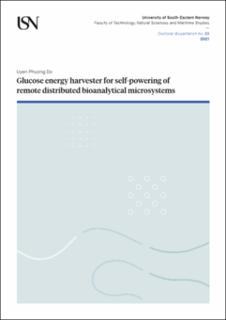Glucose energy harvester for self-powering of remote distributed bioanalytical microsystems
Doctoral thesis
Published version
Permanent lenke
https://hdl.handle.net/11250/2731786Utgivelsesdato
2021Metadata
Vis full innførselSamlinger
Sammendrag
Implantable medical devices came of age with the artificial pacemaker more than 60
years ago. Their true potential of being located directly where their prosthetic or
therapeutic actions are needed will be further enhanced by making them smaller with
the aid of microfabrication. Their Achilles heel comes at the cost of limited lifetimes of
an otherwise functional unit due to their small footprint limiting the size and energy
storage capacity of current power supply solutions based on batteries. In contrast,
chemical energy harvesters based in exogeneous fuels such as glucose and dissolved
oxygen may hold the best promise of developing a long-term energy supply due to the
relative abundance of these fuels in vivo.
This thesis focuses on the development of such a chemical energy harvester. Based on
the depletion design published in prior art, the quest has been to design a glucose fuel
cell with electrodes and catalysts that are compatible with thin film microfabrication.
These are mounted as a stacked assembly where one of the electrodes is made as a
novel porous cathode through which the reagents diffuse and the initial separation of
reagents takes place.
The first challenge of making an electrode for the selective reduction of oxygen was
realised by developing a porous cathode from e-beam deposition of palladium thin
films on ceramic aluminium oxide substrates. The porous nature of the cathodes
improved the catalytic properties by increasing the real surface area close to 100 times
of the geometric surface area. It yields an exchange current density of 2.9 × 10−3 ±
0.5 × 10−3 μA cm−2 at a dissolved oxygen concentration close to the physiological
range of 2 ppm. The sensitivity towards glucose was assessed by measuring the
decrease in the half-cell potential in the presence of 5 mM glucose to - 20.6 ± 16.1
mV under a load current density of 2 μA cm-2. The Tafel slopes were measured to
approximately 60 mV per decade. These results suggested that nanoporous AAO
cathodes coated with palladium offered a reasonable catalytic performance with a
good selectivity towards oxygen in the presence of glucose.
The second challenge of realising selective oxidation of glucose started off by
developing glucose selective anodes from the annealing of e-beam deposited thin films
of platinum (Pt) and nickel (Ni) into a Pt– Ni alloy. The roughened surface of the alloy
enhanced the electrochemical properties by increasing the real surface area to
approximately 500 times compared to the geometric surface area. Since the surface
roughness was found to scale with the annealing temperature, the corresponding
exchange current density of the electrodes annealed at 800oC was twice that of the
electrode annealed at 650oC. The potential increase due to the addition of dissolved
oxygen at the physiological concentration of 2 ppm was measured to 100 ± 8 mV
under a load current density of 2 μA cm-2. These results showed that the anodes are
relatively more sensitive to oxygen catalysis than the cathodes towards glucose
catalysis. It suggested that a shield should be made to remove the oxygen before
permitting the solution to come into contact with the anode.
Consequently, the third challenge of completing a selective oxidation of glucose and a
selective reduction of oxygen lies in the architecture of the fuel cell device. A custom
housing enabled a stacked assembly of the fuel cell “core” meaning the anode at the
bottom, covered by an ion conducting membrane, and capped with the cathode,
showed that energy harvesting from a mixed fuel environment was possible. In fact,
the cell was able of maintain a power density of 2.33 ± 0.11 μW cm-2 at a current
density of 7.7 μA cm-2 and a cell potential of 0.30 ± 0.01 V in a simulated mixed fuel
environment of 5 mM glucose and 2 ppm dissolved oxygen at room temperature. This
was 80% of the power obtained in the ideal experiment in which glucose and oxygen
were physically separated prior to use.
It was also found that the methods used to estimate the real surface area of
nanoporous electrodes were not thoroughly discussed in literature. Although this may
be clear to those already skilled in the art, mistakes can be done by those coming from
a different engineering background. Thus a subsequent study investigating different
popular ex-situ and in-situ methods was undertaken to help clarify this matter and to
identify the correct methods used for the electrode systems developed in this project.
Består av
Article I Do, U.P., Seland, F., Maharbiz, M.M., Wang, K., Johannesen, Ø., Johannessen, E.A. Thin film nanoporous electrodes for the selective catalysis of oxygen in abiotically catalysed micro glucose fuel cells. Journal of Materials Science. 2016. 51 (19): pp. 9095-9107.Article II: Do, U.P., Seland, F., and Johannessen, E.A. The Real Area of Nanoporous Catalytic Surfaces of Gold and Palladium in Aqueous Solutions. Journal of the Electrochemical Society, 2018. 165 (5): H219-H228.
Article III: Do, U.P., Seland, F., Wang, K., and Johannessen, E.A. Raney-platinum thin film electrodes for the catalysis of glucose in abiotically catalyzed micro-glucose fuel cells. Journal of Materials Science, 2019. 54 (22): pp 14143–14156. DOI: 10.1007/s10853-019-03907-9
Article IV: Do, U.P., Seland, F., and Johannessen, E.A. A micro fuel cell for abiotical catalysis of glucose. Journal of Power Sources, 2020. 478: p. 229032. DOI: 10.1016/j.jpowsour.2020.229032.
